Length-Weight Relationships and Condition Factor of Six Sole Fish species from Coastal Waters of Pakistan
Oceanography & Fisheries Open Access Journal Juniper Publishers
Abstract
The current study aimed to investigate the morphometric analysis based on length and weight relationships and condition factors of six sole fish species i.e., Cynoglossus punticeps, C. arel, C. quadrilineatus, Pseudorhombus javanicus, P. elevates, and Euryglossa orientalis belong to three different families Paralichthyidae, Cynoglossidae and Soleidae. Their feeding practices are quite different from other species as they forage mostly on bottom invertebrates, therefore, these species inhabiting in shallow muddy and sandy bottom of the continental shelf along the coast. Sole fish species were collected from five harbors i.e., Karachi fish harbor (KAH), Keti Bandar fish harbor (KBH), Korangi fish harbor (KOH), Ormara fish harbor (OFH) and Pasni fish harbor (PFH) along the coast. The significant variations were observed in morphometric parameters according to fish species. The highest condition factor was evaluated for E. orientalis (1.943) and lowest was examined for C. arel (0.469). This is the preliminary analysis from Pakistani waters and an addition of some basic information on the biology and growth of sole fish in the marine environment of Pakistan.
Keywords: Length-weight relationship; Fish assemblage; Sole fishes; Pakistan
Introduction
Length-weight relationship has a conspicuous importance to differentiate the biological stock demonstration, to understand by body condition records, figure biomass dependent on length recurrence circulations and for acoustic overviews [1-3]. Inspite of its significance and the way that these relationships are effectively acquired, they are normally absent for a few animal types, particularly those that are not economically important [3]. The relationship between length and weight is analyzed on the basis as used to explore information regarding fish condition, factors and examine the nature of the growth of fish, whether isometric or allometric [4,5]. Generally morphometric data likewise interlink between total length and total weight are essential, especially for Eco morphological studies [6,7].
An indispensable job is played by fish in the advancement of a country in spite of the fact that it is the least expensive wellspring of over-the-top nutritive protein. It has other fundamental supplements which are required to human body [8-10]. Length-weight relationship (LWR) is basic instrument in the executives of fishery it is additionally essential in fisheries the board for relative development ponders it gives vital data on the oceanic natural surroundings numerous devices were utilized in fishery science to separate fish populace, for example, hereditary and morphometric it is broadly used to realize the distinction between fish populace [11-15].
Flat fishes play a vital role in energy pathway, and it is also beneficial for conservation of benthic organisms in a form suitable for human consumption [16]. Since 1930, the relationship between Length-weight was used [17]. It was described with Cubic parabola first. W=aL3 after this procedure, it has been superseded by general parabola. The result of general parabola is much better than cubic parabola W=aLb b=2to4 to values will exist a and b they both differ between species, through annual spawning seasons [18]. When b is equal to 3 it means the growth is isometric if it is more than 3 or less than it is termed as allometric growth, thus length-weight relationship (LWR) measurement of any species prerequisite to the study about its population [19].
Fishes impart benefits to human being in plenty ways. It is also essential dietary animal basic protein source in human food [20]. The population of humans has been increasing day by day and it is inversely proportional to animal protein. The fish meat provides energy and high quality of proteins, which holds all mandatory amino acid in effortlessly digestible; thus, they are worthwhile nutritious sources [21]. The morphometric analysis can also provide the valuable information on aquatic habitat [13]. Differences appeared during the morphometric analysis are important for evaluating the species variation and structure of population on behalf of recognizing stocks [22].
Length-weight relationships of fishes are important tools in fisheries science for the various studied areas i.e., estimation of standard weight of fish species in a given length assemblage [11], growth rate, age and length structures, conversion of growth in-length equations to growth-in-weight in stock assessment models, biomass from length frequency distributions. Lengthweight relationship (LWR) considered as an imperative growth index used as a sustainable management tool by fishery biologists. Morphometric relationships among the fish used to assess and determine the possible differences between the different species and stocks of the species [12,23]. Length and weight relationship plays huge role in population dynamics and fishery biologist, where plenty stock assessment models have been entail using length-parameters.
The review of literature provides few previous studies on these important species (Table 1) Sole fishes from Cynoglossidae family are commercial fish in China. Bohai Sea and in east yellow sea [24]. Owing to overfishing, wild population is being decreased and annual output less than 1 ton now [25]. In china sole fishes are commercial fish and also culture able and these are being culture in European countries. These species are reported from both coasts of Pakistan, i.e., Makran coast and Lasbela coast including, Gwadar, jeewani, Ganz, Sur Bandar, Pasni, Ormara, Korangi and Keti Bandar. The present study intended to investigate the morphometric analysis, length-weight relationships, and condition factors of six sole fishes i.e., Cynoglossus punticeps, C. arel, C. quadrilineatus, Pseudorhombus javanicus, P. elevates and Euryglossa orientalis belong to the three families Paralichthyidae, Cynoglossidae, and Soleidae from coastal waters of Pakistan.

Materials and Methods

Flat fish sampling was conducted during a whole year of 2018 from five harbors, i.e., Karachi fish harbor (KAH), Keti Bandar fish harbor (KBH), Korangi fish harbor (KOH), Ormara fish harbor (OFH) and Pasni fish harbor (PFH) along the coast of Pakistan (Figure 1)). Fish individuals were identified up to the species level with the help of the fish identification key [26]. A total of 1238 specimens of six species (Cynoglossus punticeps, N=75; C. arel, N=216; C. quadrilineatus, N=519; Pseudorhombus javanicus, N=213; P. elevates, N=57; and Euryglossa orientalis, N=156) were used in morphometric analysis. Total length (TL) and total width (TW) measured by a stainless scale (nearest 0.1 cm), whereas total weight (TW) measured by using digital weight balance (nearest 0.01 g). Length-Weight, relationship was calculated by following equation given by Le-Cren (1951):

Where, W is the weight and L is length of fish individuals, “b” is the allometric growth parameter or slope, and “a” is termed as an initial growth factor (y-intercept). The condition factor (K) is a useful index for monitoring feeding intensity, age, and growth rates defined the well-being of the fish and was obtained using the following formula [27].

Statistical Analyses
Morphometric parameters of fishes were analyzed through basic descriptive statistics, which include mean, standard deviation, minimum and maximum. Analysis of Variance (ANOVA) was used to assess the variations in morphometric parameters regarding fish species and fish harbors and level of significance were accepted at 0.05 probability. Pearson’s correlation analysis (r2) was used to determine the relationship between morphometric parameters in fishes. Linear regression analysis (r2) was employed to evaluate the relationship between length and weight of the fishes.
Results and Discussion
The present study provides the Length -Weight relationship (LWR) and relative condition factor (k) of total of six flatfish species (Cynoglossus punticeps, C. arel, C. quadrilineatus, Pseudorhombus javanicus, P. elevates, and Euryglossa orientalis) from three families (Figure 2), namely Cynoglossidae, Paralichthyidae, and Soleidae. were collected in the current study along the coastal waters of Pakistan. The inter and intra specific variations were observed in the length and weight relationship of studied species of flat fishes in morphometric parameters (Table 2). The morphometric parameters showed significant variations (p <0.001) among the species collected from coastal waters of Pakistan. The total mean length (cm) for all the six studied fishes was significantly varied Whereas, the highest width (cm) was observed for P. javnicus (14.09) followed by P. elevates (12.85), E. orientalis (10.36), C. puncticeps (9.77), C. qudrilineatus (9.48) and C. arel (7.17). The wet weight (g) of studied fishes ranged from 301.6 to 120.5, which was observed highest for P. elevatus and lowest for C. arel (Figure 3).
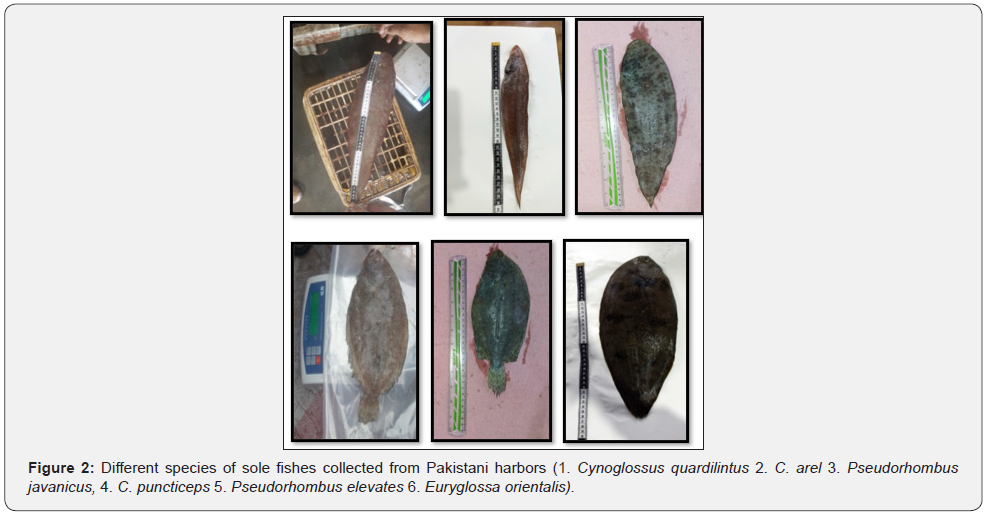
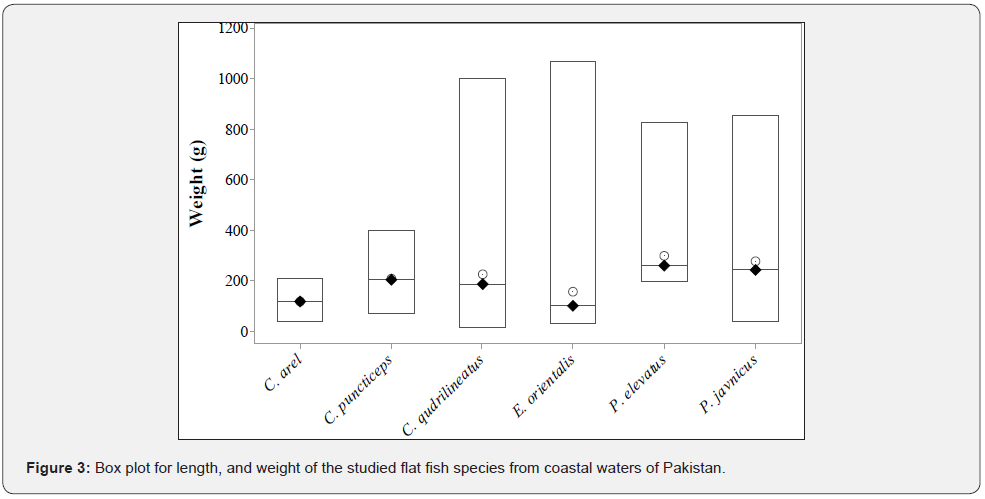
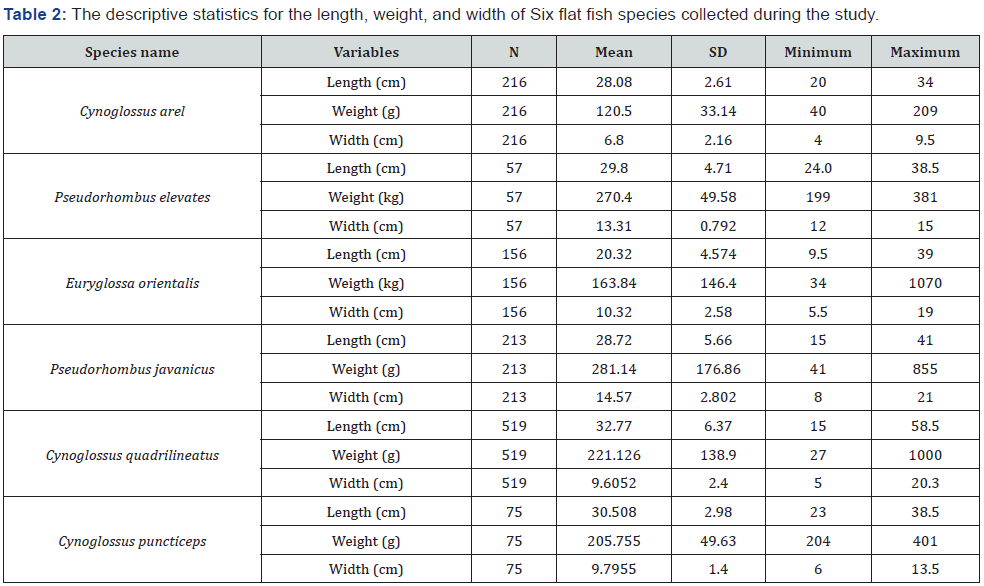
C. quadrilineatus found in abundance from all six species along the Pakistan coast. Among the sole fishes, Cynoglossus is genus of flatfish, belong to Cynglossidae family and can be distinguished by the presence of hook-on snout which is overhanging the mouth. In the current study, the “b” values were observed 2.859 as compared to the reported values (3.213) from the same fish of the family [28]. The second most abundant species P. javanicus, which was also collected from all fish harbors like C. quadrilineatus. The significant correlation (R2 = 0.83) evaluated between length-weight relationship. A positive allometry (Figure 4) was observed with the “b” values (3.043) for P. javanicus, is comparable to the reported values 3.207 for the same species [29]. Cynoglossus arel was the third most abundant species showed the significant correlation (R2 = 0.68) between length-weight relationship with a positive allometry (Figure 4).
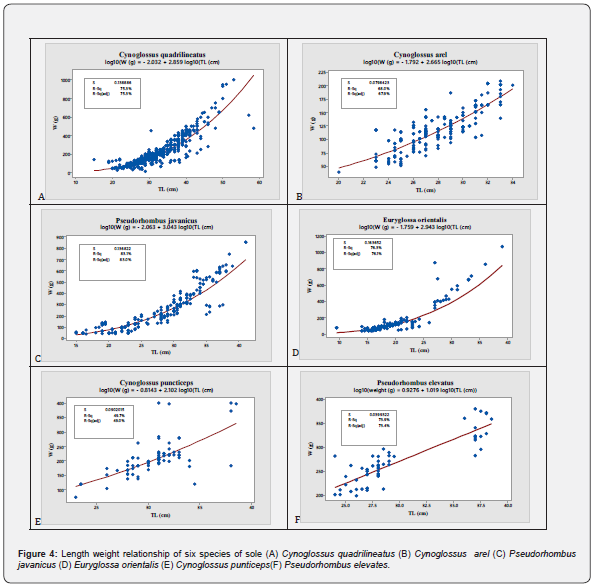
In the current study, the observed “b” values (2.859) for C. arel can be compared with the previous reported 2.923 values [30]. Pseudorhombus elevates belongs to the Paralicthidae family, which is recognized as having 67-74 rays, anal fin with 52-58 rays by its strongly ovoid body with dorsal fin. The specimen of P. elevates only procured from Karachi fish harbor along the Sindh coast. The average length, width and wet weight of fish is 29.81 cm, 12.85 cm and 301.6 g, respectively (Table 2). The positive allometry and significant correlation (R2 = 0.73) evaluated between length-weight relationship (Figure 4). In the current study, the “b” values were observed 1.019 as compared to the reported values3.290 [28]. The average length, width, and wet weight of C. puncticeps ranged from 30.11 to 32.44 cm, 9.46 to 10.13 cm and 138 to 204 g, respectively (Table 2).
The significant correlation (R2 = 0.49) evaluated between the length-weight relationship of C. puncticeps and showed isometric allometry (Figure 4). In the current study, the observed “b” values were less 2.02 as compared to the reported values 3.12 [31]. Total 156 individuals of E. orientalis were collected from two harbors i.e., Keti Bunder and Karachi fish harbors. The significant correlation (R2 = 0.76) evaluated between length-weight relationship and showed a positive allometry (Figure 4). In the current study, the “b” values were observed 2.94 as compared to the reported values 2.927 [32]. E. orientalis belongs to Soleidae family; it is a marine fish species. It populates in shallow muddy and sandy extremities of coastal waters and also in brackish water. It feeds on base enduring invertebrates, mainly small crustaceans [33].
The length-weight relationships presented the significant positive correlation for C. quadrilineatus (r2= 0.75), C. arel (r2=0.68), P. javanicus (r2=0.83), however, C. puncticeps (r2=49) showed slight negative correlation. The variations in morphometric parameters among the species most likely due to the ecological conditions of the niche and/or physiological condition of fish [20]. However, some scientists already recognized the factors affect the distribution and profusion of fish such as spawning rates, supply of food and depth of water, vegetation, breeding grounds and some other factors which have been recommended as major factors and the abundance of numerous families in Lake of Kianji [34].
The results of this study provide useful basic biological information about the most conspicuous species of fish caught in the study area that can also be compared to surrounding areas, The Fulton’s condition factor (K) is an extent as linking the length and weight for a particular fish, therefore it could be influenced by the same factors as Length and weight relationship. It was proposed that if the K value is 1.00, the condition of the fish is poor, long, and thin. A 1.20 value of K indicates that the fish is of modest condition and acceptable to numerous anglers [35]. If the fish would have a K value that is approximately 1.40 or more considered as a good and well-proportioned. The condition factor (K) for the studied species ranged from 0.406 to 1.94 (Table 3), the lowest condition factor was evaluated for C. arel that showed the less favorable environmental condition of the area for this species. Similar condition factor was described from coastal waters of Nigeria in Lagos state [36].

The higher condition factor evaluated for E. orientalis at Korangi fish harbor, which showed the favorable environmental condition in the area. Similar condition factor was described from coastal waters of Parangipettai Coast, India [37]. The condition factor (K) of C. puncticeps and C. quardilineatus was 0.735 and 0.634 respectively (Table 3), showed the moderate favorable environmental condition in the area. Similar condition factor for these species were described from coastal waters of Nigeria from Nkoro River Niger Delta [38]. For the C. arel the K value (0.469) showed the poor conditions and similar condition factor was described from coastal waters of Tighra reservoir, Gwalior, throughout May 2012 to April 2013. Tighra reservoir mendacities on 26-12’0” latitude and 78 - 30” E Longitude [39]. The condition factor (K) for P. elevatus calculated as 1.138 (Table 3), which showed the favorable environmental condition in the area. Similar condition factor was described from coastal waters of Iran muddy shores of the inter-tidal zone of Bandar Abbas city, Persian Gulf, Iran [40]. The highest (1.927) condition factor (K) was observed for E. orientalis (Table 3), which showed the favorable environmental condition in the area.
Based on this criterion, the sampled fishes along the coast were in good and moderate conditions except C. arel, However the difference in condition factor could be due to the availability of food organisms at a particular time as well as the difference of development [41]. The present data could not clarify the factors among those described above could have led to these observations. Mean values of length-weight relationship and condition factor were therefore considered to be indicators of the study area regardless the sampling locations. Moreover, in present study, the factors that affect and predictors of the length-weight relationship, such as habitat, seasonal consequence, stomach richness, preservation techniques, adulthood stage, maturity, age, and gender [42,43] were not taken into consideration. Due to such reasons, the estimated length-weight relationship and the values of a and b can be considered as the mean values, as proposed by several authors [44].
The variations in morphometric parameters among the coastal areas probably due to the ecological conditions of the niche and/or physiological status of fish [20]. It is well known that the functional regression b, value varies according to the body shape of fish and some life history parameters such as maturity, maximum size, growth rate, and others factors like habitat, stomach fullness, health, sex, age, etc., [1,4,45]. The results of this study provide useful basic biological information about the most conspicuous species of fish caught in the study area that can also be compared to surrounding areas, like the Veracruz Coral Reef System National Park [45].
Conclusion
This study aimed to investigate the morphometric analysis, length-weight analysis, and condition factor of six endemic species (Cynoglossus quardilineatus, C. arel, C. puncticeps, Pseudorhombus javanicus, P. elevatus, and Euryglossa orientalis) inhabiting in the coastal waters of Pakistan. The significant variation (p <0.05) was observed in length, width, and weight among the six fish species. The length-weight analysis showed the significant positive relationship in between length and weight of all studied fishes except negative growth relationship Pseudorhombus javanicus. The mean condition factor was examined highest for E. orientalis and was lowest for C. arel that inhabiting in coastal waters of Pakistan. The current study provides the basic information on length-weight relationships and condition factor ‘K’ for six sole fish species, and it would be utilize in biology and ecology of these fishes to manage the fin fish fishery resources in coastal waters of Pakistan.
To Know More About Oceanography & Fisheries Open Access Journal Please click on:
For more Open Access Journals in Juniper Publishers please click on:
https://juniperpublishers.com/index.php
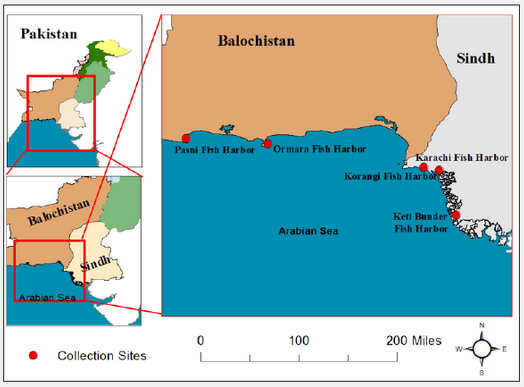
Comments
Post a Comment